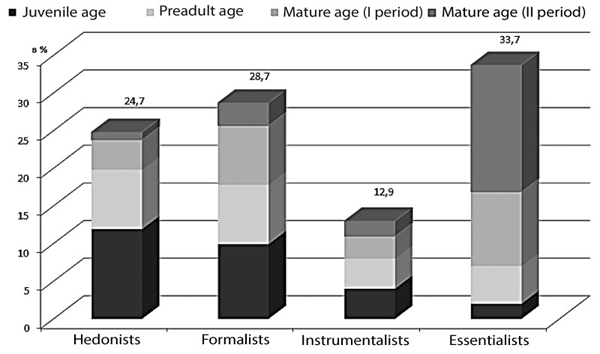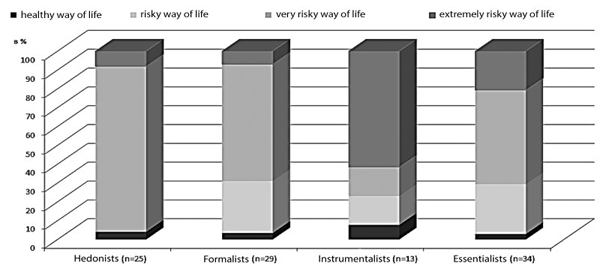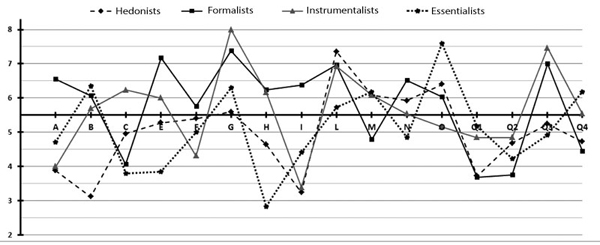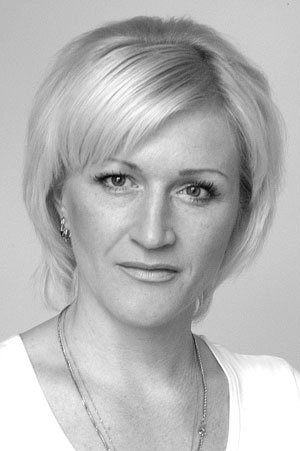Analysis of market of fitness services in view of consumer’s psychobehavioral characteristics
Фотографии:
ˑ:
Sakhalin state university, Yuzhno-Sakhalinsk
The purpose of the present study was to substantiate segmentation of the municipal market of fitness services in view of the consumers’ psychobehavioral characteristics.
The task was to study psychobehavioral characteristics of consumers of fitness services, define their peculiarities and distribute them between different typological groups.
Materials and methods. The study was organized in the Yuzhno-Sakhalinsk fitness club from December 2012 till February 2013. The sample contained 101 person (46,5% women, 53,5% men). The age structure of the respondents was presented in the following way: juvenile age – 27,7%, preadult – 24,8%, mature period I – 24,8%, mature period II – 22,8%.
The integrated research was carried out to determine psycho-behavioral characteristics of consumers of fitness services. The studied personal individual psychological characteristics were as follows: character traits (questionnaire method of assessment “16 PF of R.B. Cattell, form С); sociopsychological – system of personal values (methodology by M. Rokeach); most important ways of spending free time (ranking method by the level of increase of importance from 1 – not important to 11 – most important) 11 home and 11 outside leisure activities; respondents’ goal sets for fitness classes by rating based on the five-mark grading system – from 1 (least preferable) to 5 (most preferable) – 22 purposes of fitness classes; strength of the goal attainment motive, the success motive of the ones doing fitness (T. Elers technology); degree of adherence of consumers of fitness services to healthy way of life: value of motor activity (technology by T.N. Parfenova, O.N. Stepanova), disease incidence, keeping regular hours, adherence to bad habits (smoking, alcohol), bodymass index (BMI), personal anxiety level (Ch.D. Spielberger - Yu.L. Hanin test) and socio-demographic data. The findings were subjected to mathematical and statistical processing, along with their qualitative and quantitative analyses. The data were processed using the standard software for statistical processing of raw sociological information[1]. The classification of personality types was based on the typology, designed by L.G. Bryleva [1].
The hypothesis on the belonging of independent samples to the combinations with similar parameters was checked using the following statistical methods: Kolmogorov-Smirnov test to check the form of distribution; Kruskal-Wallis analysis of variance by ranks, Mann-Whitney Tests for independent samples; multivariative linear regression analysis with the phased method of inclusion and exclusion of independent variables to the regression model, discriminatory and hierarchical cluster analyses (the method of research of intergroup relations, Ward-Method).
We carried out a hierarchical agglomerative cluster analyses using Ward-Method with Squared Euclidean distance and discriminatory analysis as metrics to break up multitudes of subjects (consumers of fitness services), characterized by a set of measured features (surveys of R.B. Cattell, M. Rokeach), into homogenous groups. Consequently, we got a decision with four clusters. The statistically significant typological characteristics in the allocated groups of respondents were allocated using the nonparametric variance analysis by Kruskal-Wallis for several independent samples. The findings revealed the statistically reliable differences in practically all personality traits. The exclusion were the factors F and Q2 (р>0,05). The profiles of allocated groups were made and significant differences of average results for a sample in respect to the control value of 5,5 sthenes were allocated using t-tests of one sample (Fig. 1) – Yashina21.02.2013Ris1.tif). The four personality types were described in the following way: sociopsychological features (communicability - factors A, H, F), communicative features – factors Е, Q2, G, N, emotional personality characteristics (factors С, I, О, Q4, Q3; extra – F, G, L, М), intellectual personality characteristics – factors В, Q1, Е, М, N [4].

Fig. 1. Segmentation of fitness club member according to typological groups
The comparative and descriptive analyses revealed four personality types: hedonists – 24,7% of respondents, formalists - 28,7%, instrumentalists – 12,9%, essentialists – 33,7% of fitness club members (Fig. 2). According to the association х2-test, there is a statistically significant dependence (р<0,001), characterized by weak positive linearity between the allocated types and the age structure of the engaged ones (Cramer's V=0,318, р<0,001). So, juvenile age is characterized by essential personality type along with hedonistic and formalistic personality types, mature age (I period) is characterized by formalistic and essential types, while in the mature age (II period) essential personality type is dominating.
The most preferable types of leisure and determination of statistically significant differences in the studies of value orientations (M. Rokeach's method), were Kruskal–Walliss's, Mann-Whitney's ranking criteria for independent samples.
The goal sets of respondents to fitness trainings that are the most influential for the motivation to goal attainment and success (T. Elers’s method) were defined using the multivariative linear regression analysis with the phased method of inclusion and exclusion of independent variables from the regression model. The statistical characteristics of coefficients of multivariative linear regression model enabled ranking of the influence of the most important goal sets to fitness trainings, the strength of motivation to goal attainment.

Fig. 2. Classification of respondents by indices of adherence to healthy way of life

Fig. 3. Profiles of four personality types of respondents allocated by R.B. Cattell’s method (Xav)
The hierarchical cluster analysis was applied to calculate the degree of adherence of respondents to healthy way of life and resulted in four statistically significantly differing groups.
The first group included respondents leading healthy way of life. They have above average and high levels of motor activity, optimal bodymass index and very low disease incidence (once a year or less), they do not smoke or drink alcohol, have a moderate trait anxiety level and keep regular hours. The second group consisted of respondents leading risky way of life, which was distinguished from the first group by - smoking (59% of respondents of this group), underweight/overweight (54,5%), not always keeping regular hours (68,2%). The third group was made of fitness club members leading a very risky way of life. Generally, these are the people who deviate from the rules of healthy way of life in some measure. Here the statistically significant aspects are underactivity (69,5%), overweight (у 55,9%), alcohol abuse, smoking, frequent disease incidence (from 3 times a year or more) among 32,2% of respondents of the given cluster. The fourth group included respondents leading very risky way of life, who violate most of the rules of healthy way of life. They are characterized by: underactivity (73,7% of respondents of this cluster), alcohol abuse (from once a month to 1-2 times a week) - 89,5%, disease incidence from 3 times a year or more (68,4%), smoking (у 36,8%), while overweight and not keeping regular hours were marked by all respondents of this group.
Results and discussion. Proceeding from the quantitative and qualitative analyses of the findings and the analysis of the psychological content of factors by R.B. Cattell, we characterized four personality types: hedonistic, formalistic, instrumental and essential types.
Hedonists are characterized by expressed features of personal introversion: restraint in interpersonal contacts, difficulties in direct conversation, inclination to individual performance, reticence, orientation to personal inner world. The temperament is marked by softness and compliance. As for relations with people there were marked alertness, diplomacy and worldly wisdom. Social behavior is characterized by conformal reactions: adherence to moral principles and standards, dependence on the group’s opinion and needs, dependence on taken decisions.
The emotional block is characterized by emotional instability, increased anxiety. The qualities observed are: self-distrust, suspicion, low stress resistance, low emotion control, changing interests, impulsivity, efficiency, sentimentality. People of this personality type are oversatisfied emotionally. The combinations of factors show a low sensitivity, some blunted affect. These respondents have a powerful imagination, dreaminess, reflection, dissatisfaction with themselves, uncertainty, self-actualization, search for stimuli for imagination. People of this cluster are distinguished by pragmatism in behavior, difficulties with solution of practical tasks. The intellectual block is characterized by low efficiency of thinking, high general cultural level and erudition, criticism and conservatism in accepting something new, low interest in new intellectual knowledge. These respondents have powerful imagination, skill to use abstractions, which influence such a personality trait as dreaminess. The people feel difficulties with solving intellectual tasks.
It should be noted that the period of out preliminary-stating experiment on segmentation of consumers of fitness services based on psychobehavioral characteristics (December 2012 - February 2013) concurred with the period of winter school and student holidays, which were preceded by the propaganda events aimed to involve more young students of the city held by the fitness club administration. Creation of the significant discount system for this group of consumers and up to 80% of respondents of juvenile and preadult ages who train for a short time – from 1 week to 1 month in this cluster – can be explained by the present characteristics, which are more specific for the group of young people with an outsider identification.
The mean values of the factors A, В, Н, I, L, О, Q1, Q4 were the statistically significant differences from the average control value in the t-test results. Inefficient thinking and low general level of verbal culture and erudition (factor В) was a distinctive feature compared with other types.
According to the study of value orientations of this group of consumers of fitness services, freedom, love, health, good friends, active life are the primary values-goals. The least important are such values as happiness of other people, beauty of nature and art. Education, independence, rationalism, vivacity are the most important value-means for this type, while such qualities as implacability with self-imperfection and of others, sensitiveness and industriousness are the least important. The statistically significant values compared with other groups were freedom, self-confidence, rationalism, courage in assertion of personal opinion and ideas, breadth of views. All in all, the respondents of this group put them on higher places.
According to the findings of the study of the most preferable leisure activities, from the home types of leisure hedonists prefer most work on PC, internet, getting ready for work/classes, communication with friends, listening to music/radio. Games, playing with children, animal care are on the last places for the respondents of this group. From outside leisure activities the respondents preferred discos, night clubs and cinema, concerts, while work in the country house was the least preferable.
According to the study of the strength of the goal attainment and success motivations of the ones involved in fitness trainings (T. Elers method), 8% of respondents have a very low success motivation, 12% of respondents – low, 24% – average, 44% – moderately high and 12% – rather high motivation to goal attainment. The regression model (R=0,897; R²=0,8; SE=0,3; F=15.471; р<0,001; Durbin-Watson=1,6), designed based on these respondents with average and above average motivation levels showed that the most meaningful goal sets to fitness trainings for hedonists are (in the order of decreasing): spending time nicely and comfortable (β=0,507); increase muscle mass (β=0,423); remove stress, forget about studies/work (β=0,419); go for something new (β=0,366).
Proceeding from the analysis of the hedonistic way of life, only 4% of the trainees keep to healthy way of life, 88% lead very risky way of life and 8% - extremely risky.
Formalists are characterized by the expressed features of personal extraversion such as: openness, communicability, active establishment of interpersonal and social contacts, outer orientation, to other people. The behavior is characterized by expressivity, impulsivity, social courage, risk appetite, readiness to join new groups, be a leader. In social behavior the respondents of this group are noted by independence of character, alertness towards other people, flexibility and diplomacy in communication, display of conformal reactions: keeping to the group rules and opinion, accepting common rules and standards, personal ascendance, expansion as a manifestation of conformity. The emotional block is characterized by genetic emotional instability (biological dependence), flexibility of nervous system, increased anxiety, self-distrust, doubts and suspiciousness, along with high self-regulation, emotional and behavioral control, stress resistance, such people can behave impulsively. The respondents are characterized by high sensitivity, emotional sophistication, intuition, reflection, self-dissatisfaction, self-distrust. People of this personality type have concrete imagination, are focused on earthly principles, but high anxiety prevent them from being enterprising and determined. Efficiency, mobile thinking, high general cultural level, erudition are noted in the intellectual sphere. Formalists have concrete imagination, criticism and conservatism in accepting something new and are focused on concrete practical thinking.
Communicability (factor А), sensitivity (factor I) were their statistically significant distinctive features. The factors A, С, Е, G, L,N, Q1,Q2,Q3,Q4 were the statistically significant distinctions from the average control value by the t-test results.
People of the formalistic personality type put on the first places such value-goals as love, happy family life, health, good friends, well-to-do life, and on the last – beauty of nature and art and creativity. Good manners, cheerfulness, carefulness, honesty, independence are on the top of the list of value means, whilst breadth of views, courage in proving own view and ideas – on the bottom. Generally, unlike other typological groups, formalists give the priority to such values as love, happy family life, good friends, cheerfulness.
The most preferable home leisure activities for formalists are watching TV programmes, films; listening to music/radio, working on PC, in the internet, while self-education is the least important. Discos, night clubs, cinema, concerts; independent occupations of physical culture and sport are on the top among the outside leisure activities. Visiting libraries, reading rooms were the least important.
According to the results of the questionnaire, 10,3% of the trainees have low success motivation level, 69% – average, 13,8% – moderately high, 6,9% – quite high. Proceeding from the obtained regression model (R=0,829; R²=0,687; SE=0,4; F=11,537; р<0,001; Durbin-Watson=2,3) based on these respondents with average and above average motivation levels, the most important goal sets at classes in a fitness club for formalists include (in the order of decreasing): spending time nicely and comfortably (β=0,565); high sports achievements (β=0,504); getting more self-confident, feel own importance (β=0,334); arranging new partnership in business / find like-minded persons (β=0,316).
Proceeding from the study of the formalistic way of life, 3,4% of respondents are leading healthy way of life, 27,6% – risky, 62,1% – very risky, а 6,9% – extremely risky.
Instrumentalists’ communicability is characterized by self-command and reasonableness in establishment of interpersonal contacts, activity in the social sphere, which contributes to leadership in business. Communicative features indicate to independence, alertness towards other people, flexibility and diplomacy in communication, manifestation of conformal reactions: following the requirements and opinion of the group, recognizing common moral principles and standards, ascendance and expansion (authority) as a manifestation of conformity. The emotional sphere is distinguished by genetic stability, high self-regulation. Emotional and behavioral control provides tranquility, inner self-confidence and self-trust, patient reality perception. Personality is characterized as emotionally mature. However, low situational stress resistance and excessive emotional stress are possible, but it concerns only complicated important situations and can be controlled. The respondents of this personality type have low sensitivity, some blunted affect, patient reality perception, self-confidence and self-trust, some self-satisfaction. Such people have powerful imagination, can make their dreams come true, are focused on what is real, are characterized by personal practical initiative. The intellectual sphere of instrumentalists is characterized by effective, mobile thinking, high general cultural level, erudition; skill to use abstractions, powerful imagination; criticism and conservatism in recognizing something new, inclination to taking independent, uncommon intellectual solutions.
There have not been revealed any statistically significant distinctions from all other types. But the factors A,F, G,I, L,Q3 were statistically significant distinctions from the average control value by the t-test results.
People of the instrumental personality type take health, active life, life wisdom, well-to-do life, interesting job as primary value-means. Creativity, freedom and happiness of other people were the least valuable for them. The most preferable value means for instrumentalists are good manners, carefulness, efficiency, responsibility, effective entrepreneurship, but they rejected such values as cheerfulness, tolerance, responsiveness. The distinctive feature of the respondents of these groups compared with others is putting on first places such values as active motor life, life wisdom, implacability to personal imperfections and of others.
Instrumentalists value such types of home leisure as working on PC, in the internet; watching TV programs, video films; getting ready for work/studies, while home hobbies or rest on a sofa are the least preferable. From outside leisure activities they prefer independent occupations of physical culture and sport; picnics/fishing; public activities, but ignore visiting entertaining facilities.
Very low and low success motivation in activity is detected in 7,7% of respondents respectively, average – in 23%, moderately high and quite high was detected in 30,8% of respondents. The regression model (R=0,906; R²=0,821; SE=0,35; F=22,857; р<0,05; Durbin-Watson = 2,3), obtained based on these respondents with average or above average motivation, showed that the goal set of wishing to get fitter (β=0,906) is the biggest motivation in the instrumental personality type.
7,7% of the engaged ones lead healthy way of life, risky and very risky - 15,4% of respondents each and 61,5% have extremely risky way of life.
Essentialists are characterized by expressed features of personality introversion: restraint in interpersonal contacts, difficulties with direct conversation, inclination to individual performance, reticence, orientation to personal inner world. The communicative features are: lenience, flexibility, ingenuousness, but alertness towards other people is also common. In social behavior – conformity, dependence on others’ opinion, accepting common moral principles and standards, dependence in decision making. Regarding the emotional block people of this personality type are distinguished by: emotional imbalance, increased anxiety: self-distrust, suspiciousness, low stress resistance, excess stress, frustration, low emotional and behavioral control, impulsivity, efficiency, sentimentality. The combination of factors testifies to developed imagination, inclination to dreaminess, reflection, self-dissatisfaction, uncertainty, self-actualization, search for stimuli for imagination. They are characterized by orientation to personal inner world, low pragmatism in behavior, difficulties with solution of practical tasks. The intellectual block is distinguished by efficient, mobile thinking, high general cultural level, erudition. The respondents of this group are distinguished by the ability to use abstractions and powerful imagination.
The indices of the factors A, В, С, Е, G, Н, I, М, N, О, Q2,Q3,Q4 were the statistically significant distinctions from the average control value by the t-test results. They were distinguished from all other types by subordination (factor Е), timidity (factor Н).
People of the essential personality type consider the most important such value-goals as health, happy family life, love, life wisdom, well-to-do life, and put on the last place – entertainment, public recognition, happiness of other people. The most preferable value-means for them were good manners, education, honesty, tolerance of other people’s views, but they rejected high claims, implacability to personal imperfections and of others. At the same time, the value of tolerance of other people’s views was the most important in comparison with the same one in other groups.
The most preferable home leisure activities for essentialists are: games, playing with children, working on PC, in the internet; talking to friends, while the least preferable - rest on a sofa. Among outside leisure activities the respondents of this group put on the first place picnics, fishing; independent and organized occupations of physical culture and sport, and on the last – going out to cafe, bars, restaurants.
The T. Elers method was useful to reveal that 14,7% of respondents have success motivation, 20,6% – average, 38,2% – moderately high and 26,5% - quite high motivation. Based on the obtained regression model (R=0,876; R²=0,768; SE=0,4; F=11,537; р<0,001; Durbin-Watson=1,9) based on the respondents with the average and above average motivation, the essential goal sets to fitness trainings for essentialists are (in the order of decreasing): improve musculoskeletal apparatus (β=0,375); decrease disease incidence caused by professional activity (β=0,344); relieve stress, forget about work/studies (β=0,312); decrease total body weight (β=0,287); train will, courage, force of character (β=0,274).
Healthy way of life was mentioned by 2,9% of respondents of the essential personality type, risky – 26,5%, very risky – 50% and extremely risky –20,6%.
Conclusions. The practical results of the study of psychobehavioral characteristics of people involved in fitness stipulate not only for the segmentation of the municipal market of fitness services, but creating conditions for modeling of qualitative characteristics of some sphere most fully satisfying the requirements and needs of the consumers of each of the described typological groups [5].
References
- Bryleeva, L.G. Ontology of personal self-realization as a subject of applied culturology: abstract of doctoral thesis (Cult.)/ L.G. Bryleeva. – St.Petersburg, 1998. – 439 P. (In Russian)
- Vasil’ev, G.A. Consumers’ behavior: study guide / G.A. Vasil’ev. – Moscow: Vuzovsky uchebnik, 2005 – 240 P. (In Russian)
- Ganter, B. Types of consumers: the introduction to psychographics: transl. from Engl. Ed. by I.V. Andreeva / B. Ganter, A. Ferham. – St.Petersburg: Piter, 2001. – 304 P. (In Russian)
- Kapustina, A.M. Multifactorial personality method of R. Kettel: guidance / A.N. Kapustina. – St.Petersburg: Rech, 2004. – 104 P. (In Russian)
- Pasyukov, P.N. Marketing studies in municipal development of recreational physical culture: monograph / P.N. Pasyukov, S.A. Yashina. – Chelyabinsk: publ. center of UralSUPC, 2008. – 160 P. (In Russian)
- Yashina, S.A. Competitiveness of sports organization as a factor of municipal development of fitness services / S.A. Yashina // Teoriya i praktika fizicheskoy kultury. – 2012. – № 11.– P. 34–36. (In Russian)
Author’s contacts: yashina-747@rambler.ru



 Журнал "THEORY AND PRACTICE
Журнал "THEORY AND PRACTICE